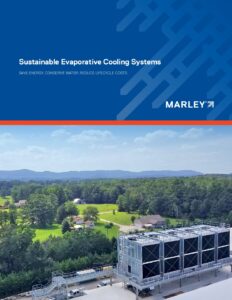Wasserschutz
Wasseraufbereitungsstrategien, die Wasseraufbereitung und Abschlämmen minimieren, können das Potenzial haben, Wasserressourcengutschriften im LEED-Programm zu erhalten. Die folgenden Prozesse bestimmen, wie effizient Ihr Kühlbetrieb Wasser nutzt:
Wasserverbrauch
Die zur Nachspeisung des Systems benötigte Wassermenge hängt von der Verdunstung, der Driftrate und dem Abschlämmen ab. Geben Sie hier Ihre Betriebsbedingungen ein, um Ihren Wasserverbrauch zu berechnen und anzuzeigen.
Verdunstung
Der Wasserverbrauch von Verdunstungskühlgeräten wird weitgehend von der Wärmebelastung und der Umgebungslufttemperatur bestimmt. Je niedriger die Wärmebelastung und/oder Umgebungstemperatur, desto geringer die Verdunstung.
Driftrate
Die Driftrate ist die Menge der Wassertröpfchen, die im Abluftstrom mitgerissen werden. Die Wassermenge, die durch Drift verloren geht, ist im Vergleich zu Verdunstung und Abblasen bei Verwendung der heutigen hocheffizienten Tropfenabscheider nahezu unbedeutend.
Abblasen
Kühlturmsysteme sind in etwa wie Luftbefeuchter oder kleine Raumverdampfer. Wenn das System über einen langen Zeitraum betrieben wird, wird das Wasser immer konzentrierter, wobei die Mineralien beim Verdunsten des Wassers zurückbleiben. Diese kleinen Systeme werden normalerweise regelmäßig entleert und durch Frischwasser ersetzt, um die Bildung von Kalkablagerungen zu verhindern. Kühltürme, Kühler mit geschlossenem Kreislauf und Verdunstungskondensatoren erfordern ein kontinuierliches Abblasen oder „Ablassen“ mit zusätzlichem Ergänzungswasser, um ein akzeptables Konzentrationsniveau aufrechtzuerhalten.
Je geringer die Anzahl der Konzentrationszyklen, desto mehr Wasser ist für das Abschlämmen erforderlich. Dieses wird zum Ersatz des verdunsteten Wassers hinzugerechnet. Bei hohen Konzentrationszyklen verringert sich die Abschlämmwassermenge, wodurch der Gesamtwasserbedarf sinkt.
Downloads:
Das in Großbritannien ansässige Magazin ACR News hat unseren Frage-und-Antwort-Artikel veröffentlicht, in dem Ingenieure und Designexperten befragt werden und in dem erklärt wird, wie Kühltürme zu erfolgreichen LEED-Projekten und anderen Nachhaltigkeitsinitiativen beitragen können.



